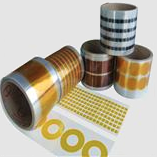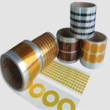PIT5N-DCD | 5 mil Die Cut Polyimide (Kapton) Film| Single Sided Discs
- Good chemical resistance
- Good solvent resistance
- High electrical resistance
Product Description
LINQTAPE PIT5N-DCD is a 5-mil, Kapton HN Film Alternative whose high performance, flexible, high-temperature resistant polyimide films used for many high temperature applications. Polyimide is preferred over polyester for many high temperature applications. These applications include but are not limited to semiconductor, smartcard, electronic, automotive and general manufacturing industries.
LINQTAPE PIT5N-DCD Series Film provides an excellent balance of electrical, mechanical, thermal, and chemical properties over a wide range of temperatures. It can be used in applications that may see temperatures up to 400°C (752°F).
LINQTAPE PIT5N-DCD polyimide tape can be delivered in a range of die cut discs sizes with diameters ranging from 1/8" to 12".
Technical Specifications
| General Properties | |||||
| Chemistry Type | Polyimide | ||||
| Color Color The color | Amber | ||||
| Film Thickness Film Thickness Film thickness is the thickness of a backing film without taking into account any coatings or adhesive layers. It is measured in micron and the conversion factor to mil is 0.039. | 127.0 µm | ||||
| Release Liner Release Liner A paper or plastic-based film sheet used to prevent a sticky surface from prematurely adhering | None | ||||
| Special Layer | None | ||||
| Total Thickness Total Thickness Total thickness is taking into account all the films, coatings, adhesives, release liners and special layers and is the maximum thickness of a film or tape. | 127 μm | ||||
| Electrical Properties | |||||
| Breakdown Voltage Breakdown Voltage Breakdown voltage is the minimum voltage necessary to force an insulator to conduct some amount of electricity. It is the point at which a material ceases to be an insulator and becomes a resistor that conducts electricity at some proportion of the total current. After dielectric breakdown, the material may or may not behave as an insulator any more because of the molecular structure alteration. The current flow tend to create a localised puncture that totally alters the dielectric properties of the material. This electrical property is thickness dependent and is the maximum amount of voltage that a dielectric material can withstand before breaking down. The breakdown voltage is calculated by multiplying the dielectric strength of the material times the thickness of the film. | 3000 V | ||||
| |||||
| |||||
| Mechanical Properties | |||||
| Elongation Elongation Elongation is the process of lengthening something. It is a percentage that measures the initial, unstressed, length compared to the length of the material right before it breaks. It is commonly referred to as Ultimate Elongation or Tensile Elongation at break. | >50 % | ||||
| Tensile Strength (Thin Film) Tensile Strength (Thin Film) Tensile strength determines the resistance of a material to break under tension and it measures how much elongating load (or tensile stress) it can handle before fracture. To make it simple, it measures how much force we have to apply when pulling apart a material before it breaks. | 24,000 N/cm | ||||
| Thermal Properties | |||||
| Temperature Resistance Temperature Resistance Temperature resistance is the maximum temperature that the material or product can withstand for a period of time. The temperatures listed should be considered as guidelines for an operating temperature of about 30 minutes. Typically, the material can withstand much longer times at temperatures about 20°C lower and can withstand much higher temperatures for short, intermittent times. | 400 ˚C | ||||
| Other Properties | |||||
| RoHS Compliant RoHS Compliant RoHS is a product level compliance based on a European Union Directive which restricts the Use of certain Hazardous Substances in Electrical and Electronic Equipment (RoHS). Products compliant with this directive do not exceed the allowable amounts of the following restricted materials: lead, mercury, cadmium, hexavalent chromium, polybrominated biphenyls (PBB) and polybrominated diphenyl ethers (PBDE), with some limited exemptions | Yes | ||||
| VOC-Free (100% solids content) VOC-Free (100% solids content) VOC means Volatile Organic compound. VOCs are evaporating molecules and are literally everywhere around us. Our scents are volatile organic compounds, most of the things that we smell are VOC etc. So what do we mean when we state that a product is VOC free? A VOC free product, according to the FTC is one where: 1)VOCs have not been intentionally added to the product. 2)The presence of VOCs at that level does not cause material harm that consumers typically associate with VOCs, including but not limited to, harm to the environment or human health. 3)The presence of VOCs at that level does not result in concentrations higher than would be found at background levels in the ambient air. | Yes | ||||



